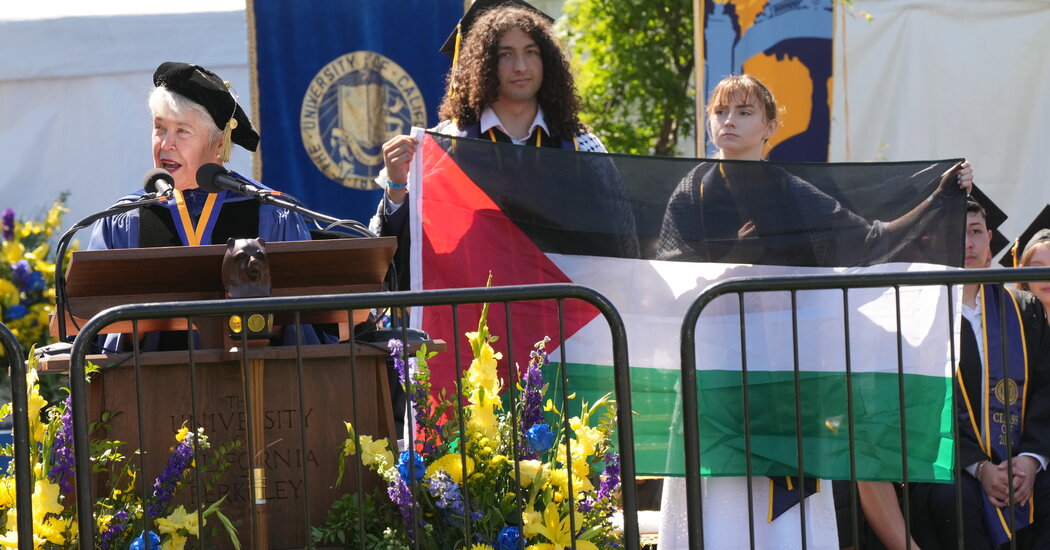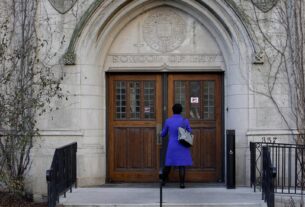Waves of boos, angry chants and the steady rhythm of feet pounding on metal seats were upending the graduation ceremony at the University of California, Berkeley.
“Viva, viva Palestina!” students sang out. “Hey, hey, ho, ho, Israel’s apartheid has got to go!”
It was the soundtrack of this year’s antiwar protest, voiced on the morning of May 11 by hundreds of cap-and-gowned graduates, loud enough to nearly drown out the ceremony’s official speakers — and force the event to halt.
One minute passed.
Two minutes.
Five.
It looked like Berkeley’s 2024 commencement was about to be canceled midstream.
Then, suddenly, surprisingly, the ceremony resumed.
Once it was over and most had left the school’s low-slung football stadium, Berkeley’s chancellor, Carol Christ, sat near the podium in a folding chair. She is silver-haired and soft-spoken, a soon-to-retire 80-year-old former English professor with an unusual background for the modern college president: Her views on free speech first crystallized during her years as a student protester in the turbulent 1960s.
When the demonstrators forced the pause, had she considered ending the event?
“Absolutely not,” Dr. Christ said. This is Berkeley, she said. “We were always going to power through. Protest is part of our core.”
Dr. Christ (her name rhymes with “wrist”) plans to retire at the end of June. The first woman appointed to the job, she leaves as the oldest chancellor in Berkeley history, and one of the oldest leaders of an elite college campus in America.
She first arrived at Berkeley as a professor in 1970, when only 3 percent of faculty members were women, the campus was almost entirely white, and the protest movement that took hold in 1964 had yet to reach its crescendo.
Now that her career is ending, Dr. Christ has had more time to reflect on the tone and tenor of campus protest, and she is worried about where it is headed.
Dr. Christ became chancellor in 2017, a year in which the conservative firebrands Milo Yiannopoulos and Ben Shapiro stirred frenzy by announcing lectures on campus. After Mr. Yiannopoulos’s appearance was stopped by what the chancellor called “a riot,” she established a free speech year on campus, complete with extra teaching about the First Amendment and a commission on dialogue set up by faculty members.
For Mr. Shapiro’s lecture, the price tag for security was roughly $600,000. But Dr. Christ said protecting a view that many on her liberal-leaning campus found odious was well worth the cost.
“I started this job during one free speech crisis,” Dr. Christ said, “and I’m leaving this job during a free speech crisis.”
This school year, Berkeley struggled with how to handle civil disobedience over the Israel-Hamas war. At universities across the country, police crackdowns have led to the arrests of more than 3,000 protesters this spring.
Berkeley got through its protests with only minor police involvement. But the university still saw enough upheaval and ugliness to trigger an antisemitism probe from House Republicans and an investigation by the U.S. Education Department.
Dr. Christ says she has always believed campuses should reflect the philosophy of John Stuart Mill: “The concept,” she said, “that you need a kind of free marketplace of ideas for truth to prevail.”
She remains wedded to First Amendment speech protections. Still, after seven years leading Berkeley, her views have an extra layer of seasoning: Mill’s ideals no longer hold up. Not in this age of acrimony and division.
Consider what unfolded on Berkeley’s campus after the Oct. 7 Hamas attacks on Israel.
There was the daily, in-your-face protest of Israel at Sather Gate, one of the campus’s main entrances. There was the clash at a lecture hall when dozens of pro-Palestinian activists broke windows and beat on doors while protesting a speech by a former member of the Israeli Defense Forces, forcing attendees to evacuate with police protection.
Activists at times profanely derided Dr. Christ, saying that she had tolerated Islamophobia on campus. Law students disrupted a dinner for graduates at the home of Erwin Chemerinsky, the law school dean who is Jewish and Zionist.
The activists had already posted caricatures of him with blood on his lips and a fork and knife — echoing an antisemitic trope, in the view of Mr. Chemerinsky, Dr. Christ and many others.
A student leader, Malak Afaneh, denied that claim, telling The New York Times, “If our dean had been a Muslim, hijabi-wearing woman that supported genocide, I would have made the exact same poster with the exact same blood.”
Pro-Israel politicians, students, donors and faculty members pressed Dr. Christ to come down hard on the activists, accusing them of antisemitism. One professor staged a sit in.
Activists erected nearly 180 tents outside Sproul Hall, famed for its free speech and antiwar rallies in the 1960s. It looked like the university might convulse with the kind of clashes that would later be seen at Columbia University, Dartmouth College, and the University of California, Los Angeles, where the school presidents brought in the police to break up encampments.
Dr. Christ, whose office features a framed 1960s photograph of the Berkeley free-speech icon Mario Savio, decided to treat the protests gently, choosing negotiation over force. Shortly after the nearly shuttered graduation ceremony, Dr. Christ brokered a deal that helped lead to the encampment’s peaceful shutdown.
Among the students’ long-held demands: recognition of Palestinian suffering and divestment from companies tied to Israel.
The chancellor offered a compromise.
She told the activists that Berkeley could not independently divest. Such decisions lie with administrators who oversee California’s public university system, and those administrators oppose such a demand.
But she pledged to issue a statement calling for an immediate and permanent cease-fire. And she promised to support an examination of Berkeley’s investments to ensure they aligned with its values, which include, she said, “a respect for equality, human rights, a commitment to fostering the conditions for human growth and development, and an abhorrence of war.”
Reaction was swift. Dozens of faculty members signed a letter repudiating the deal and chastising the chancellor for “appeasement.” A splinter group of protesters disregarded the compromise and broke into a closed, fire-damaged university building near the main campus, culminating in at least a dozen arrests.
Even leaders of the student encampment derided the chancellor’s compromise. “Too little, too late,” said a protest spokesman, Matt Kovac, who vowed that the civil disobedience would continue in the fall.
Asked whether leading Berkeley felt like being caught in a vise, Dr. Christ nodded and smiled a tight smile.
But she said calling on the police in riot gear to disband the encampment and Sather Gate protest would have been not just a disaster, it would go against her school’s cherished identity. And she recalled her own days in the 1960s, as a student at Yale, protesting the Vietnam War.
“If there was a big demonstration, I was there,” she said, adding, “I wanted to do anything I could to oppose the war.”
“The students today feel the same moral passion,” she said. “It’s the nature of students at that age. For these students, this feels like the greatest existential crisis of their being.”
“I was once that person myself.”
At the same time, things are different now, Dr. Christ said, enough to change the very nature of what it means to protest, and alter her own thoughts about free expression.
Social media has damaged nuance and empathy, she noted. Too many are siloed in chambers of information, walled from opposing views and wanting opposition silenced. There is no consensus on truth.
In previous decades, the most significant protests on her campus united students, she noted. “Now it is student against student,” she said. “Faculty member against faculty member. Staff member against staff member.” And each faction leans hard on talking over one another.
Then there is the ethos and sensitivity of the current generation, brought up with an extra awareness of slights large and small.
Students, she said, “feel sticks and stones can break my bones and names can always hurt me.”
To her, John Stuart Mill’s marketplace of ideas seems “less powerful” than ever.
“I’ve come to recognize that while freedom of speech is an absolute, just because you have the right to say something doesn’t mean it’s right to say,” she said. “We all use censorship in our speech in relation to the occasion we are in. If you value your community, you have to find ways of sharing your views that are not vitriolic, that are not needlessly hurtful to other people.”
Right now, she said, “that’s not where we are.”
Unfettered expression comes with serious responsibility. That is why Dr. Christ spent the last several months asking students to consider the way speech and protest affected the entire campus community.
Berkeley, she said, must aspire to teach students how to have civil dialogue and debate. Without that ability, she said, “we are lost.”
Dr. Christ recalled Mario Savio, known for leading Berkeley’s free speech movement in the mid-1960s.
During one student rally, a police car was surrounded by student activists near Sather Gate. Savio, the chancellor noted, climbed onto the car to give a speech but first took off his shoes to avoid damaging its roof.
Dr. Christ wondered aloud whether a present-day activist would do the same before climbing atop a police car. Probably not.
In fact, she said wryly, they just “might kick in the windows.”





